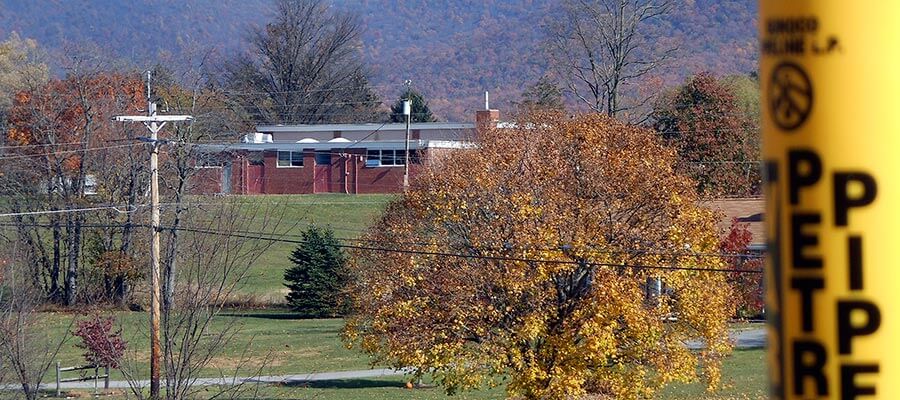
Dr. Kirk Jalbert has authored an analysis of the explosion risks of the Mariner East proposal of Sunoco Pipeline. His analysis of a 20 inch diameter pipeline transporting ethane would have a blast radius of 1,171 feet. He estimated 105,419 people to live within the Mariner East 2’s thermal impact zone. The threat to these individuals could be a significant consideration as to eminent domain power and who would be the primary and paramount beneficiary of such a pipeline.
Mariner East 2: At-Risk Schools and Populations
Written by: Kirk Jalbert, Manager of Community-Based Research & Engagement
with technical assistance from Seth Kovnant | Published in FracTracker Alliance
In September, the Pennsylvania Department of Environmental Protection (DEP) rejected a number of permits for wetland crossings and sedimentation control that were required for Sunoco Pipeline’s proposed “Mariner East 2” pipeline. According to Sunoco, the proposed Mariner East 2 is a $2.5 billion, 350-mile-long pipeline that would be one of the largest pipeline construction projects in Pennsylvania’s history.
If built, Mariner East 2 could transport up to 450,000 barrels (18,900,000 gallons) per day of propane, ethane, butane, and other liquefied hydrocarbons from the shale fields of western Pennsylvania to export terminals in Marcus Hook, located just outside Philadelphia. A second proposed pipeline, if constructed, could carry an additional 250,000 barrels (10,500,000 gallons) per day of these same materials. Sunoco submitted revised permit applications to PADEP on Tuesday, December 6th.
The industry often refers to ethane, propane and butane collectively as “natural gas liquids.” They are classified by the federal government as “hazardous, highly volatile liquids,” but that terminology is also misleading. These materials, which have not been transported through densely populated southeast Pennsylvania previously, are liquid only at very high pressure or extremely cold temperatures. At the normal atmospheric conditions experienced outside the pipeline, these materials volatilize into gas which is colorless; odorless; an asphyxiation hazard; heavier than air; and extremely flammable of explosive. This gas can travel downhill and downwind for long distances while remaining combustible. It can collect (and remain for long periods of time) in low-lying areas; and things as ordinary as a cell phone, a doorbell or a light switch are capable of providing an ignition source.
Many who have followed the proposed Mariner East 2 project note that, while much has been written about the likely environmental impacts, insufficient investigation has been conducted into safety risks to those who live, work and attend schools in the proposed pipeline’s path. We address these risks in this article, and, in doing so, emphasize the importance of regulatory agencies allowing public comments on the project’s resubmitted permit applications.
The Inherent Risks of Artificially Liquified Gas
Resident of Pennsylvania do not need to look far for examples of how pipeline accidents pose serious risk. For instance, the 2015 explosion of the Enterprise ATEX (Appalachia to Texas) pipeline near Follansbee, WV, provides a depiction of what a Mariner East 2 pipeline failure could look like. This 20-inch diameter pipeline carrying liquid ethane is similar in many ways to the proposed Mariner East 2. When it ruptured in rural West Virginia, close to the Pennsylvania border, it caused damage in an area that extended 2,000 feet—about ½ square mile—from the place where the pipeline failed.
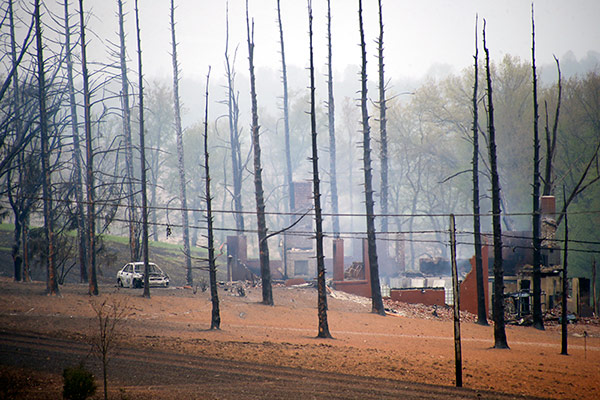
In another recent instance, the Spectra Energy Texas Eastern methane natural gas pipeline ruptured in Salem, PA, this April as a result of corroded welding. The explosion, seen above (photo by PA NPR State Impact), completely destroyed a house 200ft. away. Another house, 800ft. away, sustained major damage and its owner received 3rd degree burns. These incidents are not unique. FracTracker’s recent analysis found that there have been 4,215 pipeline incidents nation-wide since 2010, resulting in 100 reported fatalities, 470 injuries, and property damage exceeding $3.4 billion (“incident” is an industry term meaning “a pipeline failure or inadvertent release of its contents.” It does not necessarily connote “a minor event”).
Calculating Immediate Ignition Impact Zones
It is difficult to predict the blast radius for materials like ethane, propane and butane. Methane, while highly flammable or explosive, is lighter than air and so tends to disperse upon release into the atmosphere. Highly volatile liquids like ethane, propane and butane, on the other hand, tend to concentrate close to the ground and to spread laterally downwind. A large, dispersed vapor cloud of these materials may quickly spread great distances, even under very light wind conditions. A worst-case scenario would by highly variable since gas migration and dispersion is dependent on topography, leak characteristics, and atmospheric conditions. In this scenario, unignited gas would be allowed to migrate as an unignited vapor cloud for a couple miles before finding an ignition source that causes an explosion that encompasses the entire covered area tracing back to the leak source. Ordinary devices like light switches or cell phones can serve as an ignition source for the entire vapor cloud. One subject matter expert recently testified before a Municipal Zoning Hearing board that damage could be expected at a distance of three miles from the source of a large scale release.
The federal government’s “potential impact radius” (PIR) formula, used for natural gas (methane) isn’t directly applicable because of differences in the characteristics of the material. It may however be possible to quantify an Immediate Ignition Impact Zone. This represents the explosion radius that could occur if ignition occurs BEFORE the gas is able to migrate.
The Pipeline and Hazardous Materials Safety Administration (PHMSA) provides instructions for calculating the PIR of a methane natural gas pipeline. The PIR estimates the range within which a potential failure could have significant impact on people or property. The PIR is established using the combustion energy and pipeline-specific fuel mass of methane to determine a blast radius: PIR = 0.69*sqrt(p*d^2). Where: PIR = Potential Impact Radius (in feet), p = maximum allowable operating pressure (in pounds per square inch), d = nominal pipeline diameter (in inches), and 0.69 is a constant applicable to natural gas
The Texas Eastern pipeline can use the PIR equation as-is since it carries methane natural gas. However, since Mariner East 2 is primarily carrying ethane, propane, and butane NGLs, the equation must be altered. Ethane, propane, butane, and methane have very similar combustion energies (about 50-55 MJ/kg). Therefore, the PIR equation can be updated for each NGL based on the mass density of the flow material as follows: PIR = 0.69*sqrt(r*p*d^2). Where: r = the density ratio of hydrocarbons with similar combustion energy to methane natural gas. At 1,440 psi, methane remains a gas with a mass density 5 times less than liquid ethane at the same pressure:
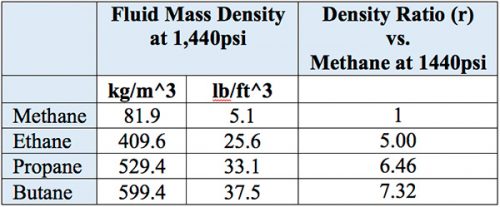
The methane density relationships for ethane, propane, and butane can be used to calculate an immediate-ignition blast radius for each hydrocarbon product. The below table shows the results assuming a Mariner East 2-sized 20-inch diameter pipe operating at Mariner East 2’s 1,440psi maximum operating pressure:

Using these assumptions, the blast radius can be derived as a function of pressure for each hydrocarbon for the same 20in. diameter pipe:
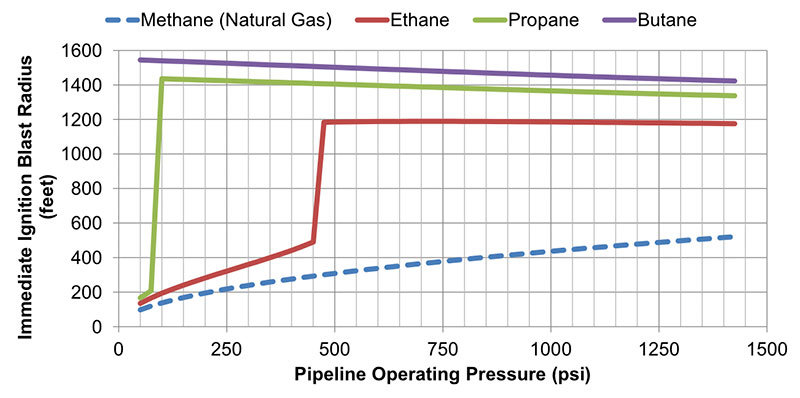
Note the sharp increase in blast radius for each natural gas liquid product. The pressure at which this sharp increase occurs corresponds with the critical pressure where each product transitions to a liquid state and becomes significantly denser, and in turn, contains more explosive power. These products will always be operated above their respective critical pressures when in transport, meaning their blast radius will be relatively constant, regardless of operating pressure.
Additional information on these calculations can be found in the Delaware County-based Middletown Coalition for Community Safety’s written testimony to the Pennsylvania Legistlature.
Living in the Mariner East 2 Immediate Impact Zone
Using the above calculations, FracTracker has created a new map of the Mariner East 2 pipeline using a highly-detailed GIS shapefile recently supplied by the DEP. On this map, we identify a 1,300ft radius “buffer” from Mariner East 2’s proposed route (the averaged Immediate Ignition Blast Radius for ethane, propane, and butane). However, we must recognize that this buffer represents a best case scenario in the event of a major pipeline accident. We then located all public and private schools, environmental justice census tracts, and estimated number of people who live within this buffer in order to get a clearer picture of the pipeline’s hidden risks.
Proposed Mariner East 2 Immediate Impact Zone with At-Risk Schools and Populations
Populations at Risk
In order to estimate the number of people who live within the impact zone, we first identified census blocks that intersect the hazardous buffer. Second, we calculated the percentage of that census block’s area that lies within the buffer. Finally, we used the ratio to determine the percentage of the block’s population that lies within the buffer. In total, there are an estimated 105,419 people living within a reasonable projection of the proposed Mariner East 2’s impact zone. The totals for each of the 17 counties in Mariner East 2’s trajectory can be found in the interactive map. The top five counties with the greatest number of at-risk residents are:
Chester County (31,632 residents in PIR)
Delaware County (17,791 residents in PIR)
Westmoreland County (11,183 residents in PIR)
Cumberland County (10,498 residents in PIR)
Berks County (7,644 residents in PIR)
Environmental Justice Areas
Environmental justice designations are defined by the DEP as any census tract where 20% or more of the population lives in poverty and/or 30% or more of the population identifies as a minority. These numbers are based on data from the U.S. Census Bureau, last updated in 2010, and by the federal poverty guidelines. Mariner East 2 crosses through four environmental justice areas:
Census Tract 4064.02, Delaware County
Census Tract 125, Cambria County
Census Tract 8026, Westmoreland County
Census Tract 8028, Westmoreland County
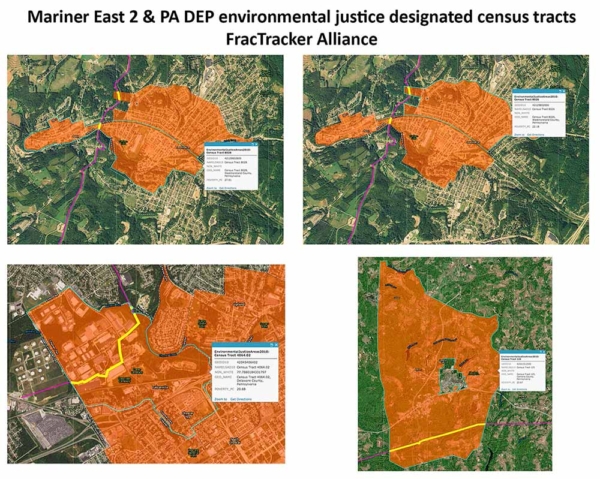
DEP policies promise enhanced public participation opportunities in environmental justice communities during permitting processes for large development projects. No additional public participation opportunities were provided to these communities. Furthermore, no public hearings were held whatsoever in Cambria County and Delaware County. The hearing held in Westmoreland County took place in Youngwood, nine miles away from Jeanette. Pipelines are not specified on the “trigger list” that determines what permits receive additional scrutiny, however the policy does allow for “opt-in permits” if the DEP believes they warrant special consideration. One would assume that a proposed pipeline project with the potential to affect the safety of tens of thousands of Pennsylvanians qualifies for additional attention.
At-Risk Schools
One of the most concerning aspects of our findings is the astounding number of schools in the path of Mariner East 2. Based on data obtained from the U.S. Department of Education on the locations of schools in Pennsylvania, a shocking 23 public (common core) schools and 17 private schools were found within Mariner East 2’s best-case impact zone. In one instance, a school was discovered to be only 7 feet away from the pipeline’s intended path. Students and staff at these schools have virtually no chance to exercise their only possible response to a large scale release of highly volatile liquids, which is immediate on-foot evacuation.
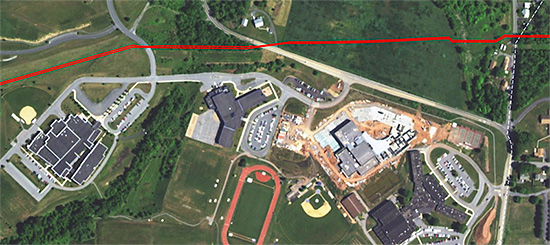
One reason for the high number of at-risk schools is that Mariner East 2 is proposed to roughly follow the same right of way as an older pipeline built in the 1930s (now marketed by Sunoco as “Mariner East 1.”). A great deal of development has occurred since that time, including many new neighborhoods, businesses and public buildings. It is worth noting that the U.S. Department of Education’s data represents the center point of schools. In many cases, we found playgrounds and other school facilities were much closer to Mariner East 2, as can be seen in the above photograph. Also of note is the high percentage of students who qualify for free or reduced lunch programs at these schools, suggesting that many are located in disproportionately poorer communities.
Click here to view a complete list of at-risk schools
Conclusion
Now that PADEP has received revised permit applications from Sunoco, presumably addressing September’s long list of technical deficiencies, the agency will soon make a decision as to whether or not additional public participation is required before approving the project. Given the findings in our analysis, it should be clear that the public must have an extended opportunity to review and comment on the proposed Mariner East 2. In fact, public participation was extremely helpful to DEP in the initial review process, providing technical and contextual information.
It is, furthermore, imperative that investigations into the potential impacts of Mariner East 2 extend to assess the safety of nearby residents and students, particularly in marginalized communities. Thus far, no indication has been made by the DEP that this will be the case. However, the Pennsylvania Sierra Club has established a petition for residents to voice their desire for a public comment period and additional hearings.
Seth Kovnat is the chief structural engineer for an aerospace engineering firm in Southeastern PA, and regularly consults with regard to the proposed Mariner East 2 pipeline. In November, Seth’s expertise in structural engineering and his extensive knowledge of piping and hazardous materials under pressure were instrumental in providing testimony at a Pennsylvania Senate and House Veterans Affairs and Emergency Preparedness Committee discussion during the Pennsylvania Pipeline Infrastructure Citizens Panel. Seth serves on the board of Middletown Coalition for Community Safety and is a member of the Mariner East 2 Safety Advisory Committee for Middletown Township, PA. He is committed to demonstrating diligence in gathering, truth sourcing, and evaluating technical information in pipeline safety matters in order to provide data driven information-sharing on a community level.
NOTE: This article was modified on 12/9/16 at 4pm to provide additional clarification on how the 1,300ft Immediate Impact Zone was calculated.








